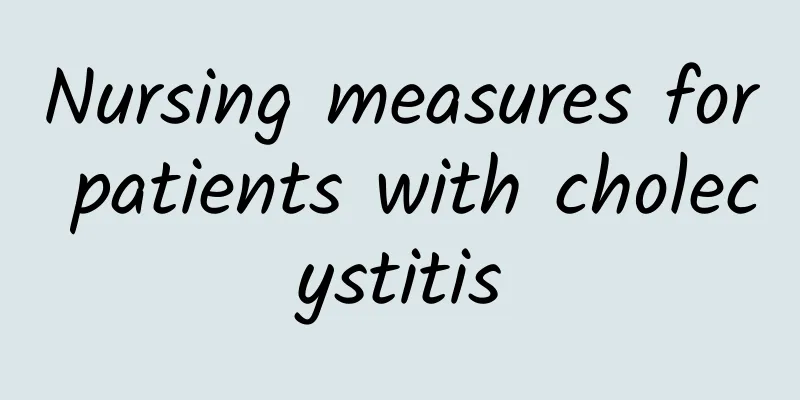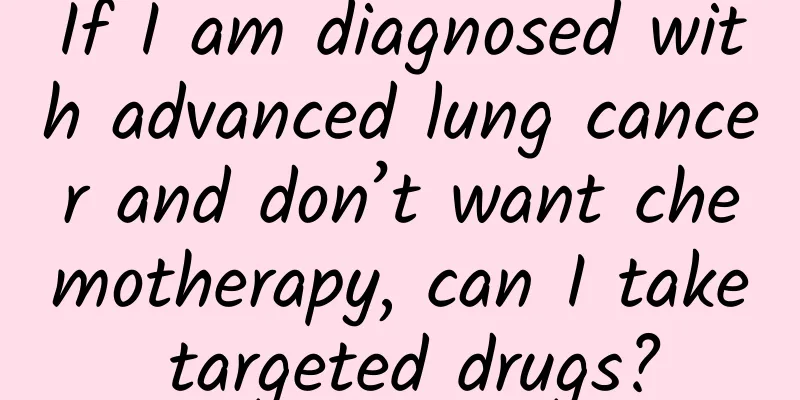Nursing measures for patients with cholecystitis

|
Cholecystitis is a common disease with a high incidence rate. It is usually caused by gallstones or pathogens in the gallbladder. The gallbladder is a small sac-like organ located below the liver. Its main function is to store bile for the digestion of fat. When the gallbladder becomes infected or inflamed, symptoms of cholecystitis will appear. What should you pay attention to in your diet for cholecystitis? How to take care of it in daily life? Let's take a look! Common symptoms of cholecystitis include: Abdominal pain: Often felt as a stabbing or cramping pain in the right upper abdomen or below the breastbone, the pain may be aggravated when eating or lying on the right side. This is because food irritates the gallbladder, triggering an inflammatory response that increases the pain. Lying on the right side reduces the distance between the gallbladder and the esophagus, making the irritation more obvious. Nausea and vomiting: may be accompanied by abdominal pain. Nausea and vomiting may be due to inflammation of the gallbladder, which leads to poor bile discharge. Bile accumulates in the gallbladder, irritating the gastrointestinal tract, causing stomach discomfort and nausea. Especially when eating high-fat foods, these foods will stimulate gallbladder contraction and bile secretion, making the symptoms more obvious. Fever: In addition to abdominal pain, nausea and vomiting, cholecystitis is sometimes accompanied by fever. It may be low-grade or high-grade and often occurs with other inflammatory symptoms such as general discomfort and headache. Symptoms of cholestasis: such as jaundice (xanthoderma), itching, etc. Jaundice is caused by cholestasis caused by cholecystitis, which leads to the accumulation of bilirubin in the body. Bilirubin is a substance in bile that is normally excreted into the intestines through the liver and gallbladder. However, in the case of cholecystitis, inflammation or obstruction of the gallbladder may prevent the bile from being discharged normally, and bilirubin will be absorbed into the blood, causing yellowing of the skin and eyes. Jaundice is often accompanied by symptoms of dark urine and lighter stools. Cholestasis may also cause itchy skin. When bile cannot be discharged normally, bilirubin and other bile components can be discharged through the skin, causing local itching. This itching usually occurs after jaundice occurs. When symptoms of cholestasis such as jaundice and itchy skin appear, medical treatment must be sought in time. Nursing measures for patients with cholecystitis : Patients with cholecystitis should avoid eating the following foods Spicy foods: Avoid spicy foods such as chili peppers, hot sauce, chili powder, and mustard. These foods may irritate the gallbladder and gastrointestinal tract, causing abdominal pain and other discomfort. Fatty meats and pork: Avoid fatty meats, especially pork. These foods may cause indigestion and worsen gallbladder symptoms. Mutton: "Medical Introduction" believes that "people with phlegm and fire" should not eat it. People with cholecystitis and gallstones often have excessive dampness and heat in the gallbladder meridian. Mutton is warming and nourishing, so it is not suitable for consumption. Eggs: Eggs (especially egg yolks) are extremely high in cholesterol. One of the factors that lead to gallstones is cholesterol metabolism disorder, so try to eat less or no eggs. Acidic foods: Acidic foods such as bayberry, hawthorn, vinegar, lemon, etc. can stimulate the stomach and duodenum to secrete cholecystokinin, thereby causing gallbladder contraction and inducing biliary colic. Daily care measures for patients with cholecystitis: 1. Diet adjustment Increase your intake of fiber-rich foods such as vegetables, fruits, whole grains, and beans. Fiber helps promote a healthy digestive system, reduces bile concentration, and prevents gallstone formation. Dividing your meals into five to six smaller meals can help reduce the burden on your gallbladder and relieve gallbladder symptoms. Avoid irritating foods such as spicy foods, caffeine, and alcohol. Maintaining adequate water intake can help dilute bile, prevent stone formation, and maintain your body's water balance. 2. Lifestyle changes Moderate aerobic exercise helps promote the health of the digestive system, enhance the discharge of bile, and prevent the formation of stones. However, avoid strenuous exercise to avoid aggravating the symptoms of cholecystitis; learn to effectively manage stress and emotions, and relieve stress through rest, exercise, meditation, etc. to reduce the onset of cholecystitis; maintain a regular work and rest schedule, and adequate sleep helps maintain the body's immune function and metabolic level, which is conducive to recovery from the disease; smoking and drinking may aggravate the symptoms of cholecystitis and increase the risk of recurrence of the disease, so these bad habits should be avoided or given up as much as possible. 3. Medication management If your doctor prescribes medication, be sure to take it as directed and pay attention to the dosage and frequency of medication. Avoid abusing medications, especially those that have adverse effects on the gallbladder and digestive system, such as nonsteroidal anti-inflammatory drugs and certain antibiotics. 4. Medical supervision Regularly perform gallbladder ultrasound or other imaging examinations to monitor changes in cholecystitis and gallstones. Pay attention to changes in physical symptoms, such as abdominal pain, nausea, vomiting, indigestion, etc., and report to the doctor in a timely manner. Strictly follow the doctor's treatment recommendations and dietary instructions, and adjust diet and lifestyle according to individual conditions to promote stability and recovery. In short, through reasonable nursing measures, patients can relieve symptoms, reduce the risk of worsening of the disease, and promote recovery. In daily life, patients with cholecystitis should pay attention to following the doctor's advice, taking medicine as prescribed, and regular follow-up visits. I hope this article can provide some useful guidance and help for patients with cholecystitis. The views in this article only represent personal opinions. If you have any questions, it is recommended to consult a professional doctor. (Zhao Chunxia, Lingshou County People's Hospital, Shijiazhuang City, Hebei Province) |
<<: Which is better, inhalation anesthesia or injection anesthesia?
>>: Prevention and care of myocarditis in children
Recommend
Why do women have right shoulder pain?
Because computers are widely used in daily life n...
The reason why my period is always black
Aunt Flo is the common name for menstruation. Men...
Should you drink more soup after the beginning of summer? Do you know the 7 tips for drinking soup?
After the Beginning of Summer in early May, the c...
What should I do if I want to have a baby after menopause?
Wanting to have a baby after menopause is a commo...
Normal yellow discharge
In daily life, many women find that their secreti...
What are the benefits of practicing Ba Duan Jin? Is Ba Duan Jin Qigong?
Ba Duan Jin is an independent and complete set of...
Preventing liver cancer starts with little things
Whether it is healthy people or patients with liv...
What to do if the vaginal discharge is excessive and yellow
Everyone knows that leucorrhea is a substance tha...
What happens if you eat chocolate during your period?
I believe that many people around us like to eat ...
What are the must-have items for the New Year? What to do if you can’t finish the New Year’s goods?
The Spring Festival is an ancient festival in my ...
What should I do if burns on my face leave scars that affect my appearance?
Burns usually leave ugly scars, especially scars ...
What is the difference between a small month and a big month?
The concept of confinement is very familiar to us...
What is the reason for delayed menstruation?
Many female friends find that their menstrual per...
What to do if your menstrual period is dark in color
Menstruation is a periodic bleeding phenomenon in...
I had brown blood during my period last week.
About a week after the end of menstruation, there...









